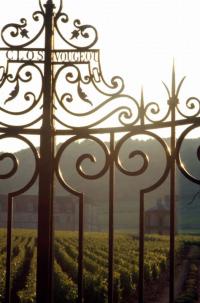Côtes de Nuits and Hautes côtes de nuits vineyard The Côte de Nuits vineyard has contributed for nearly two thousand
years to the reputation of Bourgogne wines and continues today to be one of the
world benchmarks for great red wines. Its "crimson and gold" vineyard occupies a
narrow strip of slopes which extends over twenty kilometres between Dijon and
Corgoloin, and in places is only two or three hundred metres wide. The richness
and fame of its appellations are such that some authors, when talking of the
Côte de Nuits, call it the Bourgogne Champs Elysées. The notions of
terroir, climate and clos, highlighted since the 10th century by the
monks of the great abbeys, here assume their full dimension. It is the
paradise of the
Pinot Noir which, on Mid-Jurassic limestone, produces a range of red wines
unique in the world. The Côte de Nuits vineyard has contributed for nearly two thousand
years to the reputation of Bourgogne wines and continues today to be one of the
world benchmarks for great red wines. Its "crimson and gold" vineyard occupies a
narrow strip of slopes which extends over twenty kilometres between Dijon and
Corgoloin, and in places is only two or three hundred metres wide. The richness
and fame of its appellations are such that some authors, when talking of the
Côte de Nuits, call it the Bourgogne Champs Elysées. The notions of
terroir, climate and clos, highlighted since the 10th century by the
monks of the great abbeys, here assume their full dimension. It is the
paradise of the
Pinot Noir which, on Mid-Jurassic limestone, produces a range of red wines
unique in the world.The Hautes Côtes de Nuits vineyard, which extends over twenty or more villages behind the Côte, was reconstructed in the 1950s in order to obtain a high quality wine. Pinot Noir and Chardonnay were planted on the best slopes. The efforts developed to improve quality are now bearing fruit to the full in the wines of the Bourgogne Hautes Côtes de Nuits appellation. → The soil The Côte de Nuits vineyard is on Mid-Jurassic limestone. The Hautes Côtes de Nuits vineyard backs onto the Bourgogne plateaux behind the Côte de Nuits vineyard → The climate The production of great red wines at such a northerly point is found nowhere else in the world. But the influence of the continental climate, with hot summers and dry autumns, as well as the perfect adaptation of Bourgogne grape varieties to the climate and soil conditions, explain the existence in this place of a great quality vineyard. Other determining factors include the exceptional length of sunlight and quality of light: the exposure of the vine to the sun and the total absence of waterways. The grape variety: The Côte de Nuits is the terroir where the Pinot Noir, the traditional red grape variety of Bourgogne, flourishes supremely well. However, in rare places, white Chardonnay can also be found - a traditional Bourgogne variety. Two other vine types are used to a lesser extent: Gamay for red and Aligoté for white. (Link to “grape variety” section) → The appellations : • BOURGOGNE HAUTES-CÔTES DE NUITS • CHAMBERTIN • CHAMBERTIN-CLOS DE BÈZE • CHAMBOLLE-MUSIGNY • CHAPELLE-CHAMBERTIN • CLOS DE LA ROCHE • CLOS DE TART • CLOS DE VOUGEOT • CLOS DES LAMBRAYS • CLOS SAINT-DENIS • CÔTE DE NUITS • CÔTE DE NUITS-VILLAGES • ÉCHEZEAUX • FIXIN • GEVREY-CHAMBERTIN • GRANDS ÉCHEZEAUX • GRIOTTE-CHAMBERTIN • LA GRANDE RUE • LA ROMANÉE • LA TÂCHE • LATRICIÈRES-CHAMBERTIN • MARSANNAY • MAZIS-CHAMBERTIN • MAZOYÈRES-CHAMBERTIN • MOREY-SAINT-DENIS • MUSIGNY • NUITS-SAINT-GEORGES • RICHEBOURG • ROMANÉE-CONTI • ROMANÉE-SAINT-VIVANT • RUCHOTTES-CHAMBERTIN • VOSNE-ROMANÉE • VOUGEOT Like all the Bourgogne vineyards, the Côte de Nuits produces the whole range of regional appellations: Bourgogne, Bourgogne Aligoté, Bourgogne Passe-tout-grain, Crémant de Bourgogne |
sabato 14 settembre 2013
Côtes de Nuits and Hautes côtes de nuits
Iscriviti a:
Commenti sul post (Atom)
Nessun commento:
Posta un commento